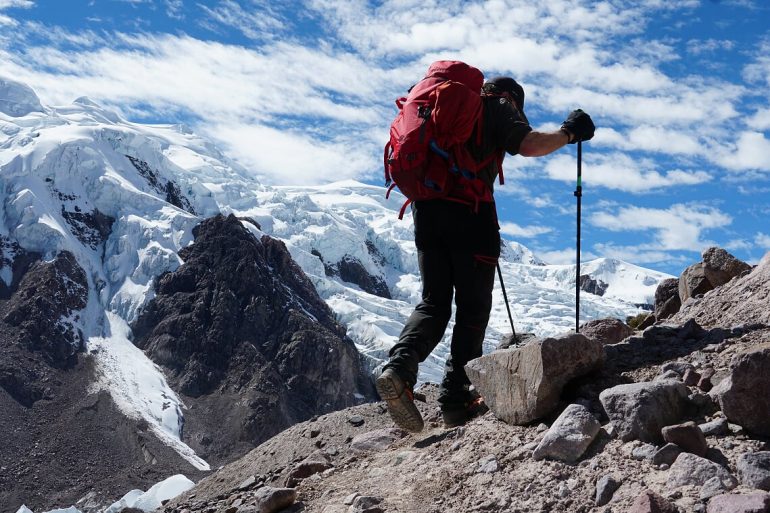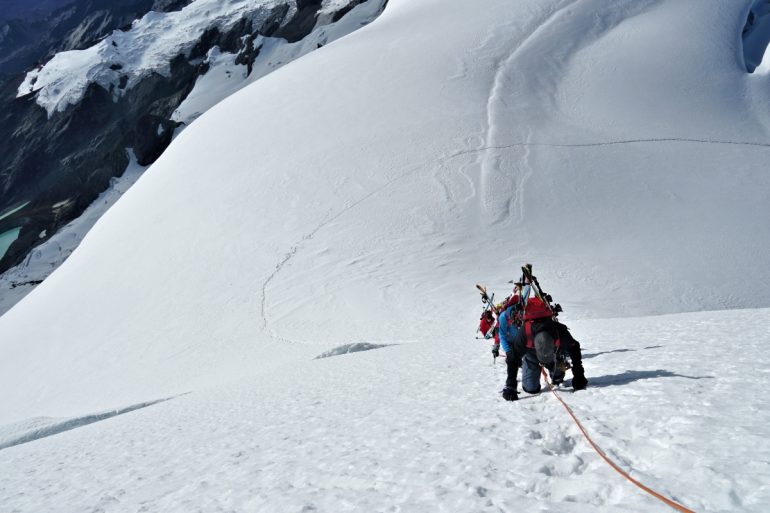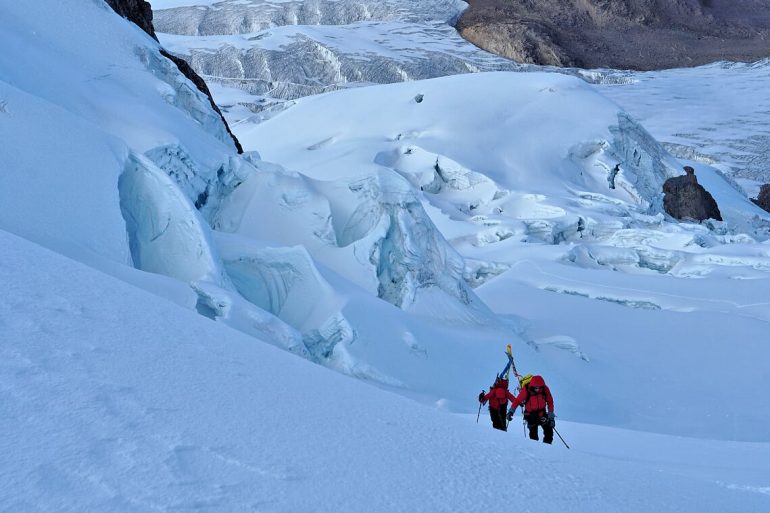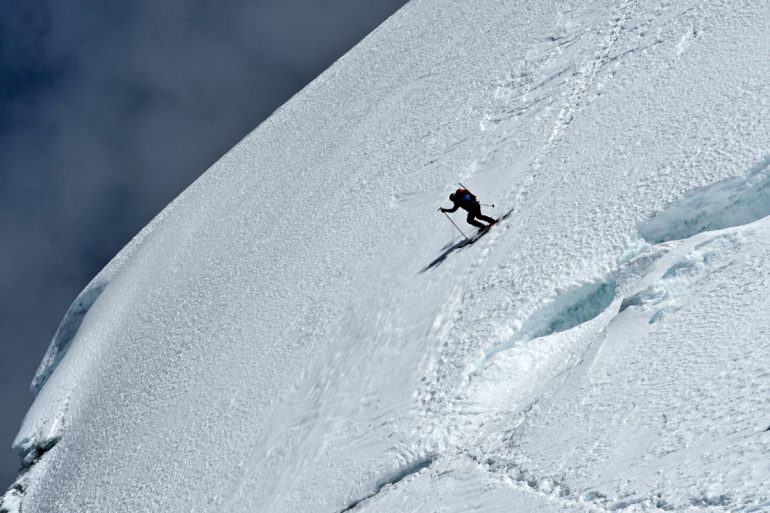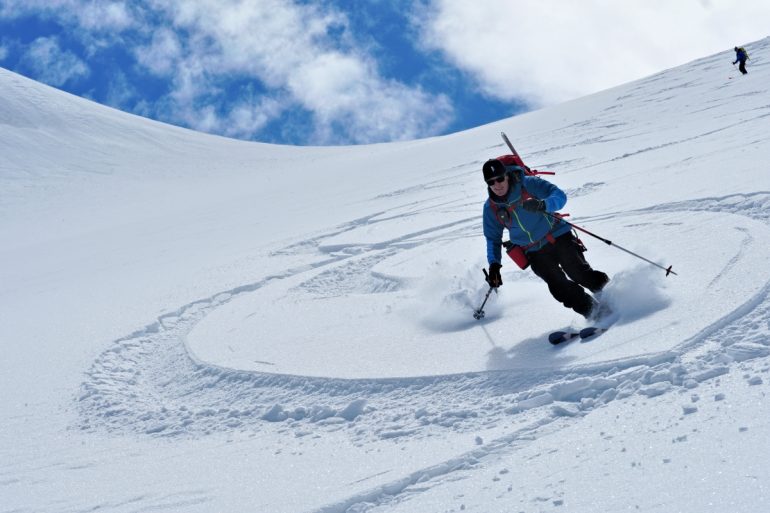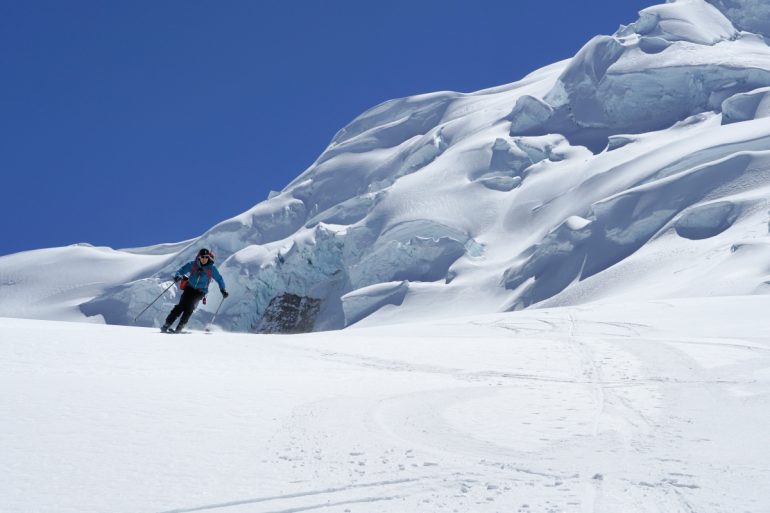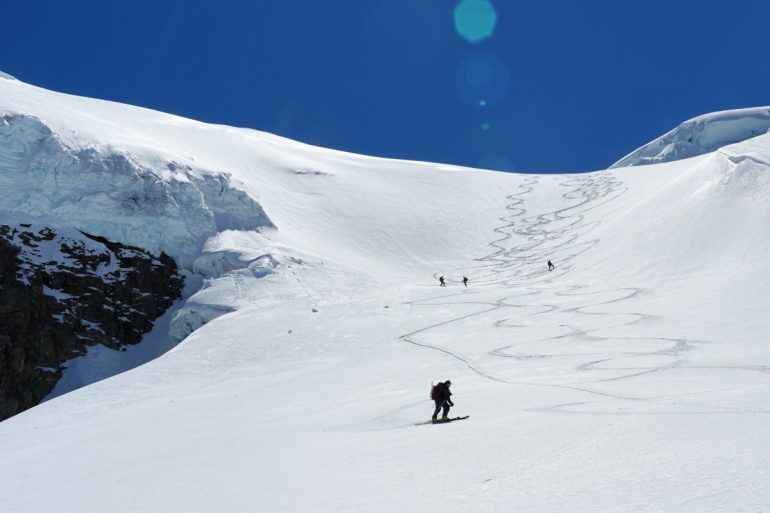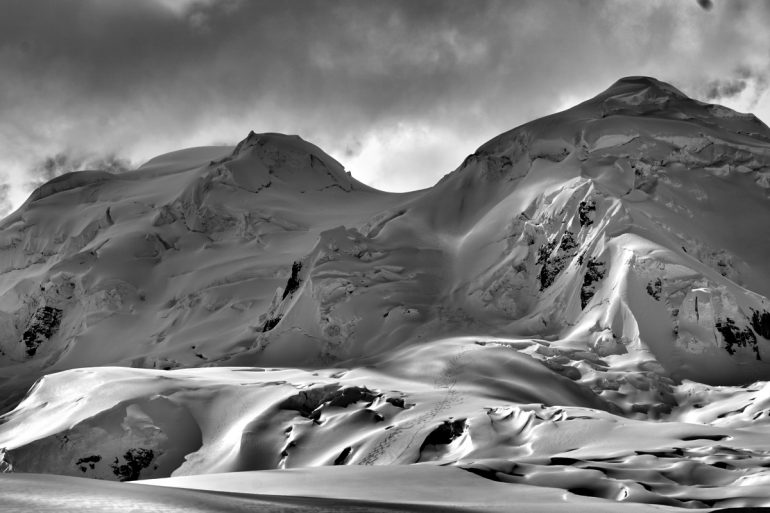
20,150 foot Nevado Chumpe. The main summit is on the left. The right summit also reaches 6000 meters. Note the ski tracks on lower slopes. Photo: Jim Gile
In Cordillera Vilcanota, Peru, Nevado Chumpe delivers
“We need to get a ski mountaineering trip together to South America,” my identical twin brother, Steve, blurted out as we sat around talking last winter. “Not the normal places,” he continued, “but some place we’ve never been.”
After a 24 or so trips over the last 30 years to the South American continent, Steve and I had explored most of the greater regions in Peru, Bolivia, Argentina, Chile and Ecuador. We found South American 6000 meter peaks to be the perfect training grounds for future 7000 and 8000 meter peak ski expeditions. South America is cheap and close, and we’ve never experienced any notable need for permits or following regulations. The Andes, we’ve determined, are there for the taking.
I immediately turned to my computer, pulled up Google Earth and started to fly my mouse around in search of white dots. Given our deep experience in the range, I was skeptical that we’d find a new area. Then it happened. In the corner of my screen near Cusco, Peru, a city famous as the launching pad for Machu Picchu, I spied a small white dot. I honed in. The typical Google Earth notes didn’t come to the screen. But the peaks were massive and the glaciers flowed well off the peaks and down the valley floors, unusual for the Andes above the ice cap of the Polar Regions. After a bit of internet work, I found some beta.
The Cordillera Vilcanota is only 40 miles long, but home to four 6000 meter summits and a plethora of 5000 meter peaks. The photos found online were of completely white peaks reminiscent of Alaska, and the glaciers cascading down the valleys reminded me of past treks to peaks in Nepal or even the Karakorum. This was a gem! Beta on climbing was nearly nonexistent, and there was nothing to be found about anyone skiing there. I called Steve and our life-long buddy Jim Gile. They gave me the green light to “make it happen.”
I found an expat American guide who had moved to Cusco, Nate Heald, who has a company there, Sky High Andes. I popped off an email and the response was simple: “This place has endless climbing and skiing…will blow your minds…I can get you in and out of the range.”
By the beginning of June, we were packed and ready. Mike Maple, another life-long buddy and Jon Gibans, both who had joined us on many expeditions eagerly came on board to round out an all Aspen expedition. Soon enough, we found ourselves in the city of Cusco at 12,000 feet, enjoying historic tourist sites and acclimating for the high adventure. After a couple days, we loaded into a bus. Four hours later we found ourselves on the Altiplano of Peru at the beginning of the southern side of the Vilcanota at 14,000 feet.
We planned walk the entire range using horses to carry our camp and gear. In photos, the peaks had appeared so outstanding and white that we feared the images old or uniquely captured after a massive snow storm. Over the years, we had relied on photos of other peaks only to find climate change and conditions had deteriorated the snow, making some not remotely even skiable. Upon setting out in the Vilcanota, though, we realized the photos were, if anything, a letdown to the view before us.
The massive white peaks with winding glaciers made this range appear as if someone cut a 40-mile swath from Himalaya in Nepal and pasted it in Peru. As we gazed on these beastly peaks, adrenaline soared as we saw endless climbing and skiing. Our single regret: we had only planned for 10 days.
As per Nate’s advice, we chose a 20,150 ft double pyramid peak called Chumpe as our first and main objective. After a four-day trek up the glacier, we arrived at our basecamp at 16,000 feet just uphill from the massive glacier flowing off the peak. We did a few day hikes to acclimate a bit before our attempt, and then we were off.
The climb involved a ski tour across a massive glacier and up moderate but skin-able slopes. We roped up due to crevasses and found ourselves managing the line as we switched back and forth up the slopes. Soon the pitch steepened, and we put the skis on our packs. We climbed the steeper slopes and switched to skis to glide across deep snow between pitches. The summit pyramid was roughly 1000 feet of hard but skiable snow on a consistent slope that we measured at a sustained 50 degrees. Nate warned us about the steep pitch, but when looking straight at it, the reality set in.
When on any summit push, you are obviously pushing past acclimatization, even if only for the brief time at altitude. Climbing a pitch that steep is anticipated with excitement. Skiing a pitch like that while knowing you are not fully acclimated is something different. This creates anxiety; you simply can’t fall on a slope that steep and long. As we climbed, however, we found smooth chalky conditions which gave us confidence the slope would be even better for the ski descent. Anxiety morphed from fear to anticipation of ideal, albeit attention-grabbing, skiing.
The weather was perfect: hard blue sky, cold crisp air, no wind. Soon we found ourselves on top, looking west over the Peruvian rain forest, and east over the Punta Atacama desert. The rainforest literally crept to the lower flanks of the backside of the mountains, which explained the pasty white appearance of the entire range. Our regret of not having time for more than a peak turned the discussion of “look at that peak,” “look at this or that face to ski,” and so on and so on. We knew we’d be back before we even clicked into our skis.
The initial ski down the steep face, as expected, demanded full concentration from our hypoxic minds. We skied with caution, but the snow was solid and our edges held firm. Steve led the charge, breaking the tension of not knowing whether the slope was skiable with cautious turns. One by one the pace of the skiing increased with the incremental confidence attained by watching your buddy jump in, fueling your own excitement to get going yourself. Below, the slopes continued to demand our attention. They were still steep enough to be exciting, but included added obstacles in the form of gaping crevasses and partially covered holes in the glacier. The thin air required short breath-catching rests between turns, but included powder skiing until the glacier panned out on the moderate but smooth slopes leading to camp. As we glided back across the flat glacier, our minds soared with satisfaction.
In our entire careers, Chumpe proved to be one of the best ski peaks we had ever been to. It also didn’t escape us that as a trio, Steve, Jim and I attained a milestone of sorts with our 20th 6000-meter peak ski descent, this one another first ski descent.
The Vilcanota exceeded all expectations. The peaks offered an amazing and unique experience for South America. Keep in mind, the basecamps of these peaks are a bit higher than most others we’ve skied throughout the Andes, meaning you won’t find massive relief in the range. This makes for shorter ski descents (around 3,000 vertical feet), but the snow conditions for skiing far exceed anything we have found on the continent rendering it a quality versus quantity situation.
But don’t let the relief fool you into underestimating the extreme nature of the range. Bluntly put, these mountains are high and demand total respect. If you get altitude sickness in the Vilcanota, your options for relief are extremely limited. A trip to this area is best treated as a trek: go slow and enjoy it. Our mistake was rushing our timeline. Take at least two weeks, or as long as you can afford. As you ascend the flowing glacier moraine, the mountain vistas coupled with massive glacial lakes throughout area will leave you with not only a fantastic ski mountaineering experience, but will burn in your memory an experience that is truly unique to the Andes, if not the world.
Mike Marolt is a USA National Ski and Snowboard Hall of Famer. He has spent the last 30 years climbing and skiing with his identical twin brother Steve and lifelong friend Jim Gile on expeditions to over 50 peaks in the 5000 meter to 8000 meter arena. He has produced several films on his expeditions and will release a book on skiing the high peaks this fall.

